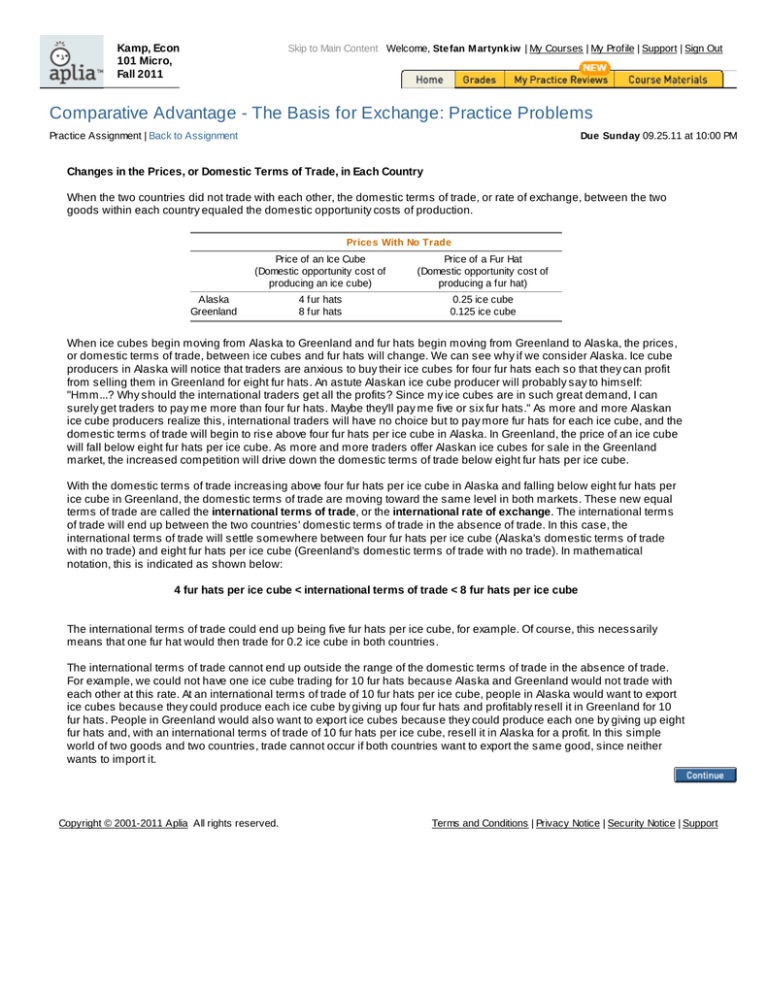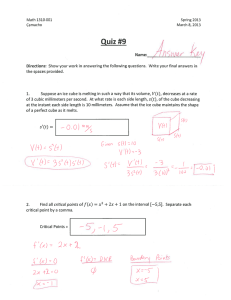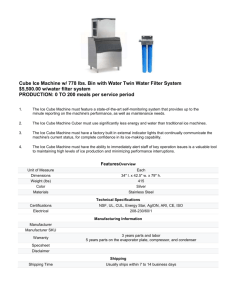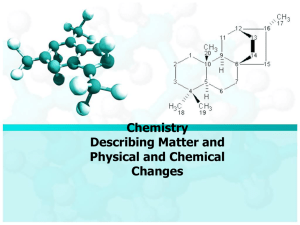
Kamp, Econ
101 Micro,
Fall 2011
Skip to Main Content Welcome, Stefan M artynkiw | My Courses | My Profile | Support | Sign Out
Comparative Advantage - The Basis for Exchange: Practice Problems
Practice Assignment | Back to Assignment
Due Sunday 09.25.11 at 10:00 PM
Changes in the Prices, or Domestic Terms of Trade, in Each Country
When the two countries did not trade with each other, the domestic terms of trade, or rate of exchange, between the two
goods within each country equaled the domestic opportunity costs of production.
Prices With No Trade
Price of an Ice Cube
(Domestic opportunity cost of
producing an ice cube)
Price of a Fur Hat
(Domestic opportunity cost of
producing a fur hat)
4 fur hats
8 fur hats
0.25 ice cube
0.125 ice cube
Alaska
Greenland
When ice cubes begin moving from Alaska to Greenland and fur hats begin moving from Greenland to Alaska, the prices,
or domestic terms of trade, between ice cubes and fur hats will change. We can see why if we consider Alaska. Ice cube
producers in Alaska will notice that traders are anxious to buy their ice cubes for four fur hats each so that they can profit
from selling them in Greenland for eight fur hats. An astute Alaskan ice cube producer will probably say to himself:
"Hmm...? Why should the international traders get all the profits? Since my ice cubes are in such great demand, I can
surely get traders to pay me more than four fur hats. Maybe they'll pay me five or six fur hats." As more and more Alaskan
ice cube producers realize this, international traders will have no choice but to pay more fur hats for each ice cube, and the
domestic terms of trade will begin to rise above four fur hats per ice cube in Alaska. In Greenland, the price of an ice cube
will fall below eight fur hats per ice cube. As more and more traders offer Alaskan ice cubes for sale in the Greenland
market, the increased competition will drive down the domestic terms of trade below eight fur hats per ice cube.
With the domestic terms of trade increasing above four fur hats per ice cube in Alaska and falling below eight fur hats per
ice cube in Greenland, the domestic terms of trade are moving toward the same level in both markets. These new equal
terms of trade are called the international terms of trade, or the international rate of exchange. The international terms
of trade will end up between the two countries' domestic terms of trade in the absence of trade. In this case, the
international terms of trade will settle somewhere between four fur hats per ice cube (Alaska's domestic terms of trade
with no trade) and eight fur hats per ice cube (Greenland's domestic terms of trade with no trade). In mathematical
notation, this is indicated as shown below:
4 fur hats per ice cube < international terms of trade < 8 fur hats per ice cube
The international terms of trade could end up being five fur hats per ice cube, for example. Of course, this necessarily
means that one fur hat would then trade for 0.2 ice cube in both countries.
The international terms of trade cannot end up outside the range of the domestic terms of trade in the absence of trade.
For example, we could not have one ice cube trading for 10 fur hats because Alaska and Greenland would not trade with
each other at this rate. At an international terms of trade of 10 fur hats per ice cube, people in Alaska would want to export
ice cubes because they could produce each ice cube by giving up four fur hats and profitably resell it in Greenland for 10
fur hats. People in Greenland would also want to export ice cubes because they could produce each one by giving up eight
fur hats and, with an international terms of trade of 10 fur hats per ice cube, resell it in Alaska for a profit. In this simple
world of two goods and two countries, trade cannot occur if both countries want to export the same good, since neither
wants to import it.
Copyright © 2001-2011 Aplia All rights reserved.
Terms and Conditions | Privacy Notice | Security Notice | Support



